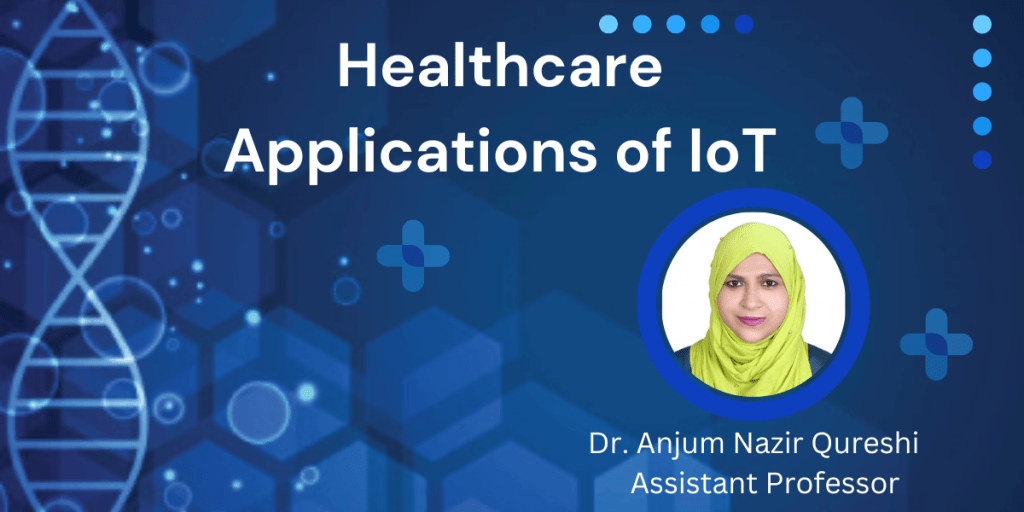Internet of Things (IoT) is one of the promising technologies that are being used worldwide. The rapid increase in the number of users indicates the increasing popularity of the technology. Its versatility has helped to use it for various applications like home automation, health care, smart grids, transportation, agriculture etc. Health care through IoT , generally termed as Smart Healthcare is one of the widely used applications of IoT. It is done by using sensors implanted on wearable devices that can be used to record and monitor health parameters.
The basic system used for monitoring health by using IoT consists of sensors used for recording the desired health parameters. The sensors can be implanted on the patient’s body in the form of a wearable sensor. The device is operated with the help of processors like Aurdino, Rasberry Pi or the Microcontrollers. The sensors are used to gather the health data. The transmitter and the receiver circuit help in transferring the collected data in the form of email notifications or messages to the doctors and relatives. The doctors respond to the notifications by prescribing the first aid and medicines to the patients once any emergency condition is detected. Some of the widely used applications of IoT in health care are:
(i) Glucose monitoring system: It uses glucose sensors to collect the glucose levels of the patient. It is useful for the people with diabetes and helps the doctor to monitor the sugar levels of the patients.
(ii) ECG Monitoring: It is implemented by using a ECG sensor to collect the physiological data of the patient from the surface of the body. A GUI interface can be used by the doctors to visualize the data , when warning messages are received.
(iii) Blood Pressure Monitoring: It can be used for collecting and analyzing the changes in blood pressure of the patient. It will give warning notifications to the doctors whenever the blood pressure is above or below the threshold levels.
(iv) Temperature Monitoring: Normal body temperatures are a sign of good health conditions. It is therefore necessary to record the body temperature. During the pandemic times, high body temperature was one of the symptoms of Covid infection. IoT enabled device can use a contact or a non-contact thermometer to record the body temperature. The contact thermometer requires physical contact while the non-contact thermometer uses an infrared sensor to record the body temperature.
(v) Oxygen Saturation Level: Oxygen saturation is an important element in patient care as hypoxemia can cause adverse effects on organs like brain, heart and kidneys. An IoT based pulse oximetry system uses a sensor to record the oxygen levels of the patient from the finger. These recorded levels are transferred to the server through the internet router and are updated in the users account.
(vi) Mood Monitoring: IoT when combined with Machine Learning or Deep Learning can be used to design a wearable to monitor and predict moods of the elderly. Machine learning can be used to train the classifiers to identify states like happiness, grief, activeness etc. Emotions can also be detected by using a microphone to record real time audio and the classifier can classify the recordings into different types of emotions. The doctor can go through the changing moods of the patient and take care of them accordingly.
(vii) Wheel Chair Management: A smart wheel chair based on IoT can be used to monitor the patients with disability and injuries. The wheel chair is programmed to move in different directions like left, right, front and back. One more important feature that can be attached is obstacle detection. It can have features like buzzer for the blind and LED for the deaf to know the obstacles. IoT is used with this chair for fall detection. The chair is programmed for a certain velocity angle and a fall is detected when the limits of velocity are found to exceed. A voice call or message can be sent to the user’s relative or the nearest hospital to inform about the situation of the user.
(viii) Fall Detection: Falling is considered to be a major health risk among the elderly people. It can cause functional impairment and affect the mobility and life quality. IoT based fall detection for the elderly can be implemented by using a wearable with sensors. The sensors gather data of the movements of the elderly which are processed and analyzed using cloud based platforms. When a fall is detected an alert is generated for the family members and the health care professionals.
Author
Assistant Professor,
Rajiv Gandhi College of Engineering Research & Technology, Chandrapur
